
This is a placeholder text
Group text
by seeofred on 04 April 2013 - 19:04
K9GSD78 thank you very much for sharing your experience and posting links about digestible clay.
As for canola oil, I guess canola plant these days in North America is mostly GMO, so if we people can consume GMO canola oil on a daily basis, I don't see a reason why animals can't do the same. (btw. AlfaAlfa found in many "premium" pet foods is also mostly GMO) http://www.huffingtonpost.com/margie-kelly/genetically-modified-food_b_2039455.html
I do agree that feeding raw is the best option, but time and money is a playing factor in not going that route.
Beetree, just out of curiosity, what do you feed your dog(s)?
P.S. It is to mention that after the first morning intake of 2 liter of water, my dog barely drinks any water for the rest of the day. My assumption is that he drinks around 3 liters of water (less than a gallon) per day.
by k9gsd78 on 04 April 2013 - 19:04
Also, as Eldee mentioned, I always moisten my dogs meals with warm water. Don't know if either the coconut oil or moistening the food would make a difference for you, but may be worth a try.
by beetree on 04 April 2013 - 19:04
Truthfully? I am smelling a sales pitch. Just the other threads on various nutrition regimens at this very moment should explain why your "read it somewhere's" philosophy is not the best, maybe, to base feeding for your best friend, and well, I recommend you should read a few. And trust me, I am being nice as can be.
My mixed breed blue pup is raw fed, has always been since he was rescued as a newborn. My shepherd eats grain free kibble, canned foods, and raw. I supplement with yogurt, eggs, cottage cheese, raw liver, freeze dried tripe, probiotics, pumpkin, my own special veggie cube concoction to mix in. Oh yeah, and coconut oil, we just started with that, awesome stuff. I'm sure I left something out. Not a single clay ingredient. Not a one.
by Bhaugh on 04 April 2013 - 22:04
I do agree with Eldee on how to tell what the kibble is like. I have done this many times with rescue dogs who may not get raw. Usually it takes about 20 min of HOT water mixing with the food to tell how dehydrated it is. Some foods Ive moistened were just as hard an hour or two after I applied water. The poor pancreas!
Ive fed dogs once a day (kibble only not raw) and some who get a twice a day feeding. I think it just depends on your dog. I always worry about bloat esp if the dog is consuming mass amounts of water with food. Consumers would probably be appauled by the amount of salt added to dog food. So if its added to the ingredient list, I wont buy the food. I dont think Orijen adds salt and I found Core as well.
Try feeding the raw even for a week and see if your dog stops drinking so much water. I can get thigh/leg combo's for about .79lb. Not a bad price imo.
Barb
by Eldee on 05 April 2013 - 09:04
When feeding raw, never say never i say, what nutrients do you add to make sure the dog is getting all the required nutrition from the raw. How do you get all the vitamins and minerals into the raw diet? Do you have a recipe?? And.. if I cooked it would I be defeating the purpose??
Thanks
by Bhaugh on 05 April 2013 - 13:04
by seeofred on 05 April 2013 - 14:04
Dog food that I feed my dog until recently was 6 Fish Orijen (still have one largest bag unopened).
Dog food that i feed my dog for the last 10+ days is Nature`s Variety Instinct LID Lamb
Test was performed under the room temperature conditions (22 Celsius).
I took 1 cup of each dry dog food and mixed it with 1 cup of warm water each (around 40 Celsius). Temperature of the water was same for both foods.
I let it both soak in warm water for 30 minutes, 1 hour and 2 hours.
My conclusions are as fallow:
After 30 minutes of soaking both kibble did absorb some water. It appeared that Instinct LID lamb absorbed slightly more (around 5-10%) water than Orijen. It is to note that neither kibble did expend to much from its original size (maybe 10-15%). Both kibble still had their original shape, Instinct LID lamb appeared to be little more mushier than Orijen, Both were still not mushy enough to loose their round shape.
After 1 hour of soaking it appeared that Instinct LID Lamb absorbed more water than Orijen 6 fish. However both kibble still were not completely mushy to lose their round shape. Both kibble did not expend their size by more that 40%.
After 2 hours of soaking Instinct LID lamb absorbed almost all the water, it was soft on the touch and if pressed slightly would turn into mush. My guess is that after two hours of soaking this kibble did not expend more than 60% of its original size.
After 2 hours of soaking Orijen 6 fish there was still some water left unabsorbed.Kibble was also soft on the touch but some were still harder than the others (in the same batch). I needed little more effort to turn them into mush then Instinct LID lamb. It is also to note that the size of this kibble after two hours of soaking did not expend (grow in size) for more that 60%.
I have attached pictures of this little test process and results. Please note that I forgot to take pictures after 2 hours of soaking.
See the results for your self and make your own conclusions.
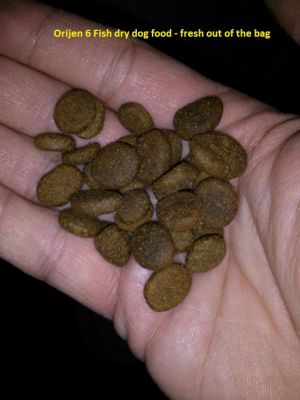
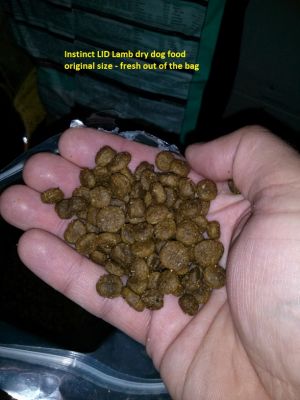
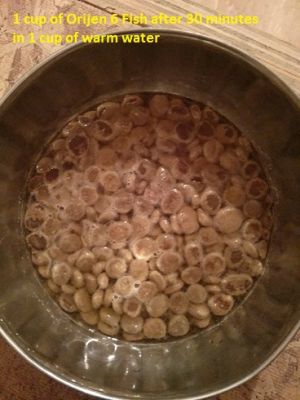
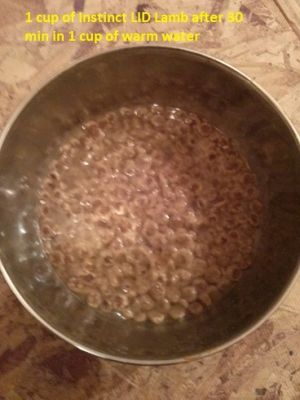
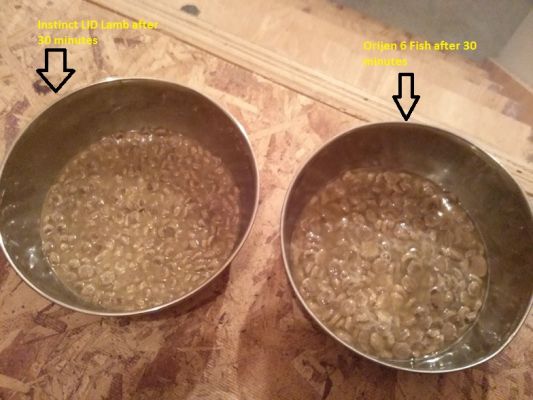
.jpg)
by Eldee on 05 April 2013 - 17:04
I feed Maya Back to Basics, after 20 minutes of soaking in warm water it is mushy. Just the way I like to feed it.
Interesting to note, I also feed Maya the Medi cal gastro intestinal vet food, which by the way after 10 minutes of soaking turns to marshmellows. Which is probably why it is good for dogs with digestive disorders. If it turns that soft in 10 minutes that is exactly what a dog needs that has a difficult time digesting food, ie EPI or IBD.
by OGBS on 05 April 2013 - 18:04
Taken from: http://www.2ndchance.info/bloat.htm
Do Veterinarians Know What Causes Gastric Dilatation/Volvulus ?
Not precisely.
But we do know some things most dogs with GDV have in common. First off, they are usually deep-chested large breeds. They also tend to be older dogs. We know that dogs that do not get routine, outdoor exercise seem more prone to develop GDV. We also know that dogs that are feed primarily dry kibble dog food , particularly in one or two large portions during the day, are more susceptible than dogs that munch throughout the day or are fed canned or moist home made diets. We know that dogs are more likely to develop GDV if their parents, siblings or prior litters did. It also appears that feeding diets with a high fat content predispose dogs to this condition.
Rumors about one cause or another have circulated for years. Some breeders believed that exercise just after or before eating brings on GDV and we used to think that dogs developed GDV when they just ate too much. In this theory, dogs that drank after a large meal of dry chow caused the food to rapidly expand. This theory assumed that the enlarged stomach then flipped over during rough exercise. We now know that the actual explanation is not nearly that simple. We also know that GDV is associated with abnormal muscular contractions of the stomach walls. These, plus the kink that forms in the stomach’s openings, prevent the dog from belching out swallowed air. Lack of normal motility and circulation in the stomach when this occurs; cause the body to become too acidic (metabolic acidosis). We also know that dogs who eat from elevated dishes appear more likely to become bloated - their dishes should always be on the floor. A 2000 Purdue Veterinary School study confirmed most of these suspicions. Dogs that ate primarily dry dog chow were almost three times as likely to develop GDV. High fat content, citric acid and premoistening the food also increased risk. High meat-content dog foods tended to decrease risk. Those authors suggested that withholding water for about an hour before and after meals might be helpful. You can read that study here.
In 2012 another important study of GDV in 1,114 dogs was published. In that study, the feeding of dry dog chow was again an important risk factor. Dogs fed one large meal a day rather than more frequent small meals were at greater risk of GDV. In this study, moderate exercise after meals and throughout the day appeared to lessen the likelihood of GDV. Large and giant breed deep-chested dogs were, again, most at risk. History of the problem in the genetic line (pedigree) made the problem much more likely. Pre-moistening the dry food with water and keeping the bowel high were not helpful - the opposite was true. You can read the study results here.
Many owners of GDV dogs describe them as greedy eaters.
by seeofred on 05 April 2013 - 19:04
I guess last few post and my own ``experiment`` has somewhat turned us away from my original question `what do you think about this food - Nature`s Variety Instinct LID lamb``
We are now all talking about GDV, which is not a bad thing at all (talking about it).
To summarize postings about GVD:
- GVD - if it happens it can be very dangerous for your dog. On average 30% turned into deadly outcome.
- Researches about GVD are still in early stages and nobody know for sure what is causing this condition.
- There is several contradicting studies abut GVD, however almost all of them are concluding that the dry kibble is the main cause of the condition.
- Up to this point studies have shown that feeding your dog 3 or more times per day (smaller meals) will decrease the chance of GVD.
- Not exercising one hour before or after the meal will decrease the chances of GVD.
- Raising the food bowl from the floor will NOT decrease the chance of GVD.
- Slowing the dog`s food intake by using food bawls which are design for that will eventually decrease the chance of DVG.
- Pre-moistening the dry dog food to decrease the chance of DVG is stil open to discussion as there is researched in favor and against this practice.
- Some studies are showing that DVG could be also a genetic predisposition.
My reason to turn from Orijen 6 Fish dry dog food to Nature`s Variety Instinct LID Lamb was to stop my dog of having intermittent runny stools (i.e. to limit the food allergy possibility by using once source of protein and one source of starch by not compromising the quality of the food and ingredients as well as protein and fat levels). I am still ``experimenting with this for me new dog food, so far it looks promising but real result will be shown in about 2-3 months of usage.
Contact information Disclaimer Privacy Statement Copyright Information Terms of Service Cookie policy ↑ Back to top




